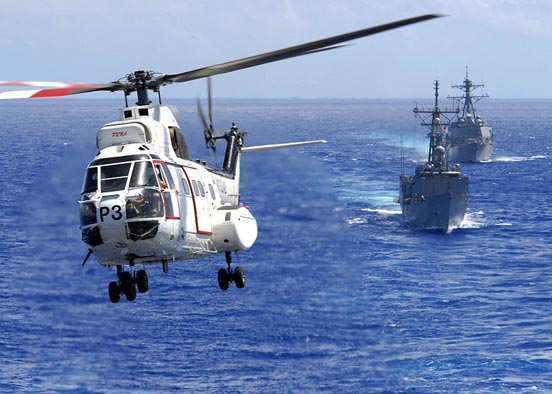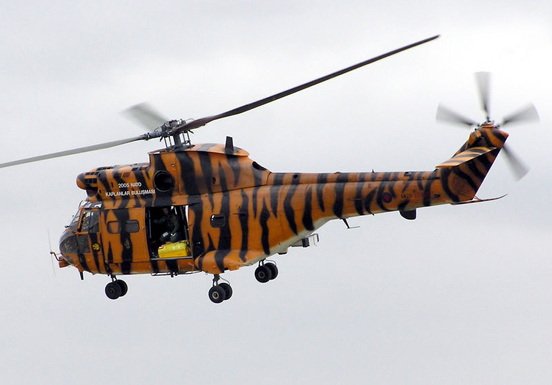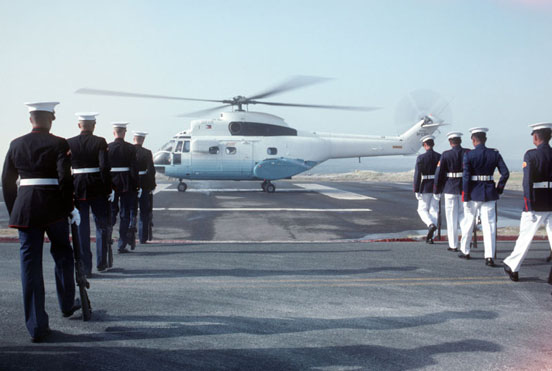 |
|
By
Wikipedia,
the free encyclopedia,
http://en.wikipedia.org/wiki/A%C3%A9rospatiale_Puma
The Aérospatiale Puma is a four-bladed, twin-engined medium transport/utility helicopter. The Puma was originally manufactured by Sud Aviation of France under the designation SA.330.
Development
The SA.330 Puma was originally developed by Sud Aviation to meet a requirement of the French Army for a medium-sized all-weather helicopter. The helicopter also had to be capable of operating by day and night as well as in a wide variety of climates.
In 1967, the Puma was also selected by the Royal Air Force (RAF) and given the designation Puma HC Mk.1. As a result of this decision, the SA 330 was included in a joint production agreement between Aerospatiale and Westland Helicopters of the UK.
The first of two Puma prototypes flew on 15 April 1965. Six pre-production models were also built, the last of which flew on 30 July 1968.
The first production SA 330 Puma flew in September 1968. Two years later, in 1970, Sud Aviation merged with Nord Aviation and SÉREB to form Aérospatiale, and the helicopter has been associated with that name ever since, though it still retained the "SA" (for "Sud Aviation") model designator. On 25 April 1978, the SA 330J Puma achieved the distinction of becoming the first helicopter outside the (then) Soviet Union to be certified for all-weather operations, including icy conditions.
Production of the SA 330 Puma by Aérospatiale ceased in 1987, by which time a total of 697 had been sold. The Puma was then replaced by an upgraded and improved version, the Eurocopter AS332 Super Puma.
Variants
Aérospatiale versions
- SA 330A
- Prototypes, originally called "Alouette IV".
- SA 330B
- Initial production version for the French Army Aviation. Powered by 884 kW (1,185 hp) Turbomeca Turmo IIIC4 engines. 132 purchased by France.
- SA 330 "Orchidée"
- SA 330 modified to carry an "Orchidée" battlefiled surveillance radar system with a rotating underfuselage antenna, for the French Army. One demonstrator was built, flying in 1986. The Orchidée programme was cancelled in 1990, but the prototype rushed back into service in 1991 to serve in the Gulf War, leading to production of a similar system based on the Eurocopter Cougar.
- SA 330C
- Initial export production version. Powered by 1,044 kW (1,400 hp) Turmo IVB engines.
- SA 330E
- Version produced by Westland Helicopters for the RAF under the designation Puma HC Mk. 1.
- SA 330F
- Initial civilian export production version with Turbomeca Turmo IIIC4 turboshaft engines.
- SA 330G
- Upgraded civilian version with 1175 kW (1,575 hp) Turbomeca Turmo IVC engines.
- SA 330H
- Upgraded French Army and export version with Turbomeca IVC engines and composite main rotor blades. Designated SA 330Ba by the French Air Force. All surviving French Army SA 330Bs converted to this standard.
- SA 330J
- Upgraded civil transport version with composite rotor blades and of [[Pakistanihigher maximum take-off weight.
- SA 330L
- Upgraded version for so-called "hot and high" conditions. Military equivalent to civil SA 330J.
- SA 330S
- Upgraded SA 330L (themselves converted from SA 330C) version for the Portuguese Air Force.Powered by Turbomeca Makila engines.
- SA 330Z
- Prototype with "fenestron" tail rotor.
Versions by other manufacturers
- Atlas Aircraft Corporation Oryx
- This is a remanufactured and upgraded SA 330 Puma built for the South African Air Force.
- IPTN NAS 330J
- This is a version that was assembled by IPTN of Indonesia under the local designation NAS 330J and the Aerospatiale designation of SA 330J. Eleven units were produced.
- ICA IAR 330
- This is a licence-built version of the SA 330 Puma manufactured by ICA of Romania. Designated as the SA 330L by Aerospatiale.
- Westland Puma HC Mk.1
- This is the SA 330E version assembled by Westland Helicopters for the RAF. This is basically similar to the SA 330B used by France. The RAF placed an initial order for 40 Pumas in 1967, with a further eight attrition replacement aircraft in 1979. 30 of these are planned to be upgraded to Puma HC Mk.2 standard, with new Turbomeca Makila engines, revised cockpit displays and new communications, navigation and defensive systems.
Operators
Military operators
 | |
The SA 330J Puma. |
 | |
Westland Puma HC1 of the RAF. |
 | |
Philippine Air Force Super Puma boarding US and Philippine Marines at Subic Bay |
 Albania (police) Albania (police) Argentina Argentina Belgium (police) Belgium (police) Brazil Brazil Cambodia Cambodia Cameroon Cameroon Chile Chile Côte d'Ivoire Côte d'Ivoire Ecuador Ecuador Ethiopia Ethiopia France France Gabon Gabon Gambia Gambia Guinea Guinea- (1 helicopter)
 Indonesia Indonesia Iran Iran Kenya Kenya
 Kuwait Kuwait Lebanon Lebanon- 10 helicopters pledged by UAE and to be delivered . Additionally 7 SA330L are currently in storage.
 Malawi Malawi Mexico Mexico Morocco Morocco Nepal Nepal Nigeria Nigeria Pakistan Pakistan Philippines Philippines
 Portugal Portugal Romania Romania Slovenia Slovenia South Africa South Africa
- South African Air Force: On the 31 January 1972 the SAAF Puma became involved with operations in Namibia and Angola, remaining involved until 1988. This first deployment to the Eastern Caprivi led to the first member of the SAAF to be awarded the Honoris Crux, one of several to be awarded to Puma crews. The Puma was to be involved in normal trooping, rapid deployment during “follow up” operations, radio relay, evacuation of casualties, rescuing downed aircrew, insertion of Special Forces (Ops Backlash and Kodak etc.) and large scale cross border operations such as Savannah, Uric, Protea, Super, Moduler etc. The Puma also saw action in Rhodesia, Zambia, Botswana and Mozambique.
 Spain Spain Sudan Sudan Togo Togo United Arab Emirates United Arab Emirates United Kingdom United Kingdom
- Royal Air Force The RAF ordered 48 Puma HC Mk 1 and in addition received a single ex-Argentine SA 330L captured in the Falklands War, and six ex-South African SA 330Ls purchased in 2002.
 Venezuela Venezuela Zaire Zaire
Civil operators
Helog KG Germany SA 330J
Starlite Aviation South Africa SA 330J
Evergreen Aviation USA SA 330J
Specifications (SA 330H Puma)Data from Jane's All The World's Aircraft 1976-77
General characteristics
- Crew: 3
- Capacity: 16 passengers
- Length: 18.15 m (59 ft 6½ in)
- Rotor diameter: 15.00 m (49 ft 2½ in)
- Height: 5.14 m (16 ft 10½ in)
- Disc area: 177.0 m² (1,905 ft²)
- Empty weight: 3,536 kg (7,795 lb)
- Max takeoff weight: 7,000 kg (15,430 lb)
- Powerplant: 2× Turboméca Turmo IVC turboshafts, 1,175 kW (1,575 hp) each
Performance
Armament
Popular culture
In Red Dawn (1984) and most notably Rambo: First Blood Part II (1985) and Rambo III (1988), an SA-330 Puma was equipped with stub wings and a gun turret to mimic a Soviet Mil Mi-24 Hind.
See also
Related development
Comparable aircraft
Related lists
External links
Text from Wikipedia is available under the Creative Commons Attribution/Share-Alike License; additional terms may apply.
Published in July 2009.
Click here to read more articles related to aviation and space!
|
 |



